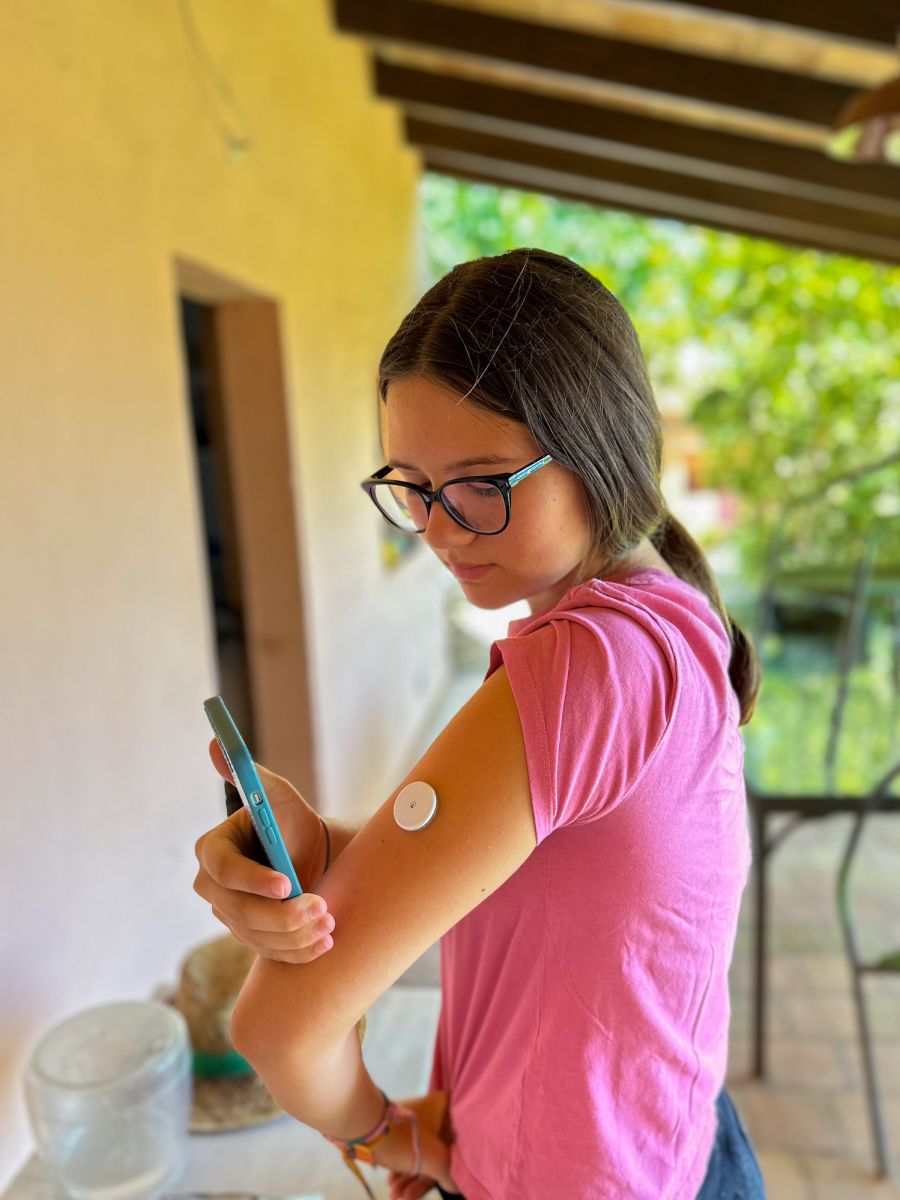Daily Life With a Continuous Glucose Monitor
By Alan Uphold
 Using a CGM has transformed diabetes management for Alan Uphold, who has type 1 diabetes and hypoglycemic unawareness. He discusses with others the power of using a CGM.
Using a CGM has transformed diabetes management for Alan Uphold, who has type 1 diabetes and hypoglycemic unawareness. He discusses with others the power of using a CGM.
A couple of years ago, I wrote an article for diaTribe about the importance of discussing hypoglycemic events with friends and family.
I have acute hypoglycemic unawareness. My blood sugar could be as low as 30, yet I would show no symptoms whatsoever of hypoglycemia. As you can imagine, this is very dangerous on many levels. But thanks to my continuous glucose monitor (CGM), my risk of having a hypoglycemic episode has been dramatically reduced.
While my previous article focused primarily on the need to talk about the lows, I wanted to share how a CGM system has changed my life as well as the lives of others. Hopefully, this information can help you decide if a CGM is right for you or someone you love.
How do CGMs work?
Let me begin by saying that several companies make continuous glucose monitors. I use the Dexcom G6 CGM, but there are numerous others in the U.S. like the Dexcom G7, Abbott’s FreeStyle Libre, Medtronic’s Guardian, and Senseonics’ Eversense.
If you’re new to CGMs, in short, a small sensor and transmitter are either placed on or inserted under your skin. The transmitter sends continuous glucose readings to your mobile phone or electronic device every 1-5 minutes, depending on the system.
CGMs also provide data on the rate your glucose is rising or falling, daily trends in blood sugar readings, and the ability to share data with loved ones and your medical team.
“These technological tools provide real-time support and information,” said Dario Rahelić, director of the diabetes, endocrinology, and metabolic diseases clinic at Merkur University Hospital in Croatia. “Numerous studies support the effectiveness of CGMs in improving glycemic control, reducing hypoglycemic events, and enhancing the quality of life for individuals with diabetes.”
How do CGMs impact daily life with diabetes?
In this article, I wanted to share with you the experiences of three people using CGMs: a recently diagnosed person with diabetes (Kaylen and her spouse, Cait), the parent of a child with diabetes (Mark and his 5-year-old daughter, Rio), and me (from the perspective of me and my husband, Jeff).
Because Kaylen, Rio, and I were diagnosed at different times and stages in our lives, our experiences using CGMs are different.
Kaylen, 35, was diagnosed about two years ago and started using a CGM shortly thereafter. Mark said they started Rio on a CGM and insulin pump within two weeks of her diagnosis at age 3.
As for me, 58, I was diagnosed with type 1 diabetes in 1997 when CGMs were not yet in widespread use; I didn’t try using a CGM until 2014 – 17 years after my diagnosis. Since then, the Dexcom G6 CGM system has truly been life-changing for me.
Looking back, it’s hard to imagine what life was like when I had to determine my blood sugar levels using finger sticks multiple times a day.
The most obvious problem with finger sticks was that they only provided a snapshot in time. My sugar at the precise moment that I took the reading might have been 100 mg/dL, but this did not indicate whether my sugar was stable, or on its way up or down. More importantly, I had no idea how quickly my glucose levels were increasing or decreasing.
I wasn’t the only one for whom using a CGM changed things. CGM systems have fundamentally altered the way Kaylen and Rio think about and manage their diabetes, too.
 For instance, Kaylen said she loves the outdoors and activities like hiking and biking. She said that having a CGM has enabled her to pursue outdoor activities confidently and without fear of having low blood sugar while out on one of her adventures.
For instance, Kaylen said she loves the outdoors and activities like hiking and biking. She said that having a CGM has enabled her to pursue outdoor activities confidently and without fear of having low blood sugar while out on one of her adventures.
Mark said that having his daughter Rio connected to a CGM is an important part of learning how her body reacts to food and the insulin she takes. All recently diagnosed people with diabetes have a learning curve and need to make adjustments, of course, but this learning curve is especially critical for young children. With readings every five minutes, the CGM system has helped Rio’s family understand the changes and nuances in her glucose readings.
“Technology has been changing the management of type 1 diabetes in kids,” said Dr. Ivana Rabbone, a pediatrics professor and diabetes researcher based in Italy. “The use of CGM in adults and kids with type 1 reduces A1C levels and prolongs the time spent within time and range.”
All CGMs allow users to set device alerts for when their blood sugar reaches a certain level – either too high or too low.
I have mine set for a “low” of 70 mg/dL and “high” of 200 mg/dL, which means as my sugar starts to drop and gets to 70 mg/dL (or rises above 200 mg/dL), an alarm goes off. I also have a setting for “urgent low” that is set for 55 mg/dL. If I don’t take action, the alarm gets louder – something which is especially helpful for a deep sleeper like me.
CGMs also allow users to track patterns. One pattern I discovered was that I was experiencing a dip every day around 10:30-11:00 a.m., indicating that I needed to take a little less short-acting insulin at breakfast.
While your doctor can make recommendations about managing your health issues, ultimately, you are responsible for your own body. That’s why understanding these patterns is a key part of diabetes management.
The benefits of CGMs for friends, family, and caregivers
 Perhaps one of the most important aspects of a CGM system is you can connect other people to it so they can also track your glucose levels.
Perhaps one of the most important aspects of a CGM system is you can connect other people to it so they can also track your glucose levels.
My husband of 26 years, Jeff, gets alerts about my blood sugar just as I do. He described my using a CGM as “a complete and absolute game changer.”
Jeff said knowing that we both receive alerts of a low has cut his worries by 90%. More importantly, it’s helped him understand more about my diabetes. He said he doesn’t panic anymore when my blood sugar starts to drop. That reduced sense of panic has led him away from overtreating a low when I’m having one.
Cait and Kaylen said that before Kaylen got a CGM, Cait would constantly be hovering over her shoulder every time she did a finger stick test. Of course, Cait still hovers a bit, but now it’s from a safe distance while sitting on the couch and looking at the CGM’s companion app on her phone.
Depending on the system you use, CGMs can alert between five and 20 friends and family members about your glucose levels.
For Rio, in addition to both parents, her information is transmitted to her nanny, school nurse, elementary school director, and three medical professionals – one of whom is Mark’s brother.
When Mark notices that Rio’s blood sugar is dropping and approaching 100 mg/dL, he alerts school personnel and tells them to be prepared to give her some apple juice. Even though Rio has a lot of people monitoring her blood sugar levels, Mark said it’s a great comfort that he personally knows what’s happening at any given moment.
Rio isn’t the only one who benefits from sharing this information with others. Both Kaylen and I have had low episodes while we were away from people linked to our CGMs, and they were able to get help.
In Kaylen’s case, while attending a conference she felt drowsy and laid down for a moment. As she was about to drift off to sleep, Cait noticed that Kaylen was having a low. Cait was able to call and wake her up.
I’ve had similar experiences. On more than one occasion Jeff has noticed my glucose dropping when I’m not with him and has checked in to make sure that I have some sugar.
Perhaps most importantly, all three of us – Kaylen, Rio, and I – have seen tremendous success in achieving time in range with a CGM.
Continuous glucose monitors not only help prevent hypoglycemic episodes, but they also help prevent hyperglycemic episodes (high blood sugar). Since time in range is such an important aspect of diabetes management, CGMs provide another significant benefit in keeping our A1C at the appropriate level.
“We can unequivocally show that when you give patients access to a CGM it offers long-term benefits like lowering A1C when compared to patients who are using finger sticks,” said Tomas Walker, vice president of medical affairs for Dexcom.
Studies have also shown CGMs to be beneficial in improving long-term outcomes for diabetes-related complications like retinopathy and liver disease. With so many benefits, why would anyone object to getting a CGM?
“People think, ‘I don’t want to have to mess with it, or it’s too complicated,’ but CGMs have become easier to use. Unfortunately, we still hear stories of providers who tell their patients that it’s too complicated,” Walker said. “The truth is it’s not hard to understand when your device shows an arrow pointing up or down indicating that your glucose going up or down.”
Other barriers to CGM use are access to the technology, adequate education from healthcare providers on how to use it, and cost – especially if not covered by insurance. But these technologies are becoming easier to use and less expensive with every system update.
For me, and for the other families with whom I spoke, the use of a CGM boiled down to one key phrase: “peace of mind.” While it’s true that you can learn a lot about your body, your glucose patterns, and how your diet affects glucose, the thing that we all agreed upon was that being able to prevent hyperglycemic episodes – and more critically, hypoglycemic episodes – was the most important thing.
Knowing that you will receive an alert when your blood sugar is too high or too low and being able to share that information with the people who care about you outbalances any objection you may have.
Learn more about CGMs and other tech for diabetes management here:








